Young talent is the name of the game, folks.
In today’s NHL, an emphasis is put on speed, skill, and youth. If you look around the league, almost all the top teams are led by young, cost-controlled talent. The top six scorers on the league-leading Colorado Avalanche are at or under the age of 27. The defending champion Tampa Bay Lightning have just two regulars over the age of 30. And the rising Carolina Hurricanes have seen a serious youth movement in full effect over the last few years.
The Hurricanes spent a decade in the doldrums of the NHL. Actually, it was more like hockey purgatory; rarely were they truly terrible – which was not really ideal, because it kept them drafting in the 5-12 range basically every year – but never good enough to make the playoffs or, especially, contend for a Stanley Cup. That’s troublesome when the best bet to build a contender begins with drafting and developing, ideally getting stars at the top of those drafts. Unfortunately, the Canes were just kind of stuck.
Finally, a general manager came along that worked them out of this frustrating loop, and a few short years later (well, don’t say that to Canes fans, but in retrospect, it kind of is) the Hurricanes have one of the most enviable groups of young, controlled talent along with a stacked prospect pipeline working its way up through the ranks (from “2021 NHL Team Prospect Rankings, The Athletic, February 9, 2021). You may think I’m talking about Don Waddell, and that would be a fair assumption. However, I am actually taking it back to his predecessor, Ron Francis.
The former Hurricane captain and NHL legend played a significant, imperative role in building who the Hurricanes are today, and often does not get his due. Saying Francis was perfect as GM is far from accurate – you could even argue his stint wasn’t particularly good. But, he did lay a foundation for the current regime to cash in on.
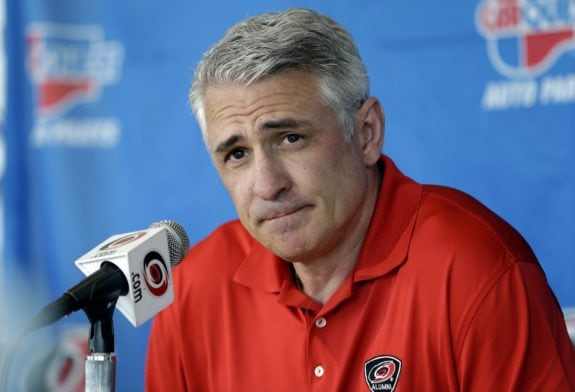
So, what steps, exactly, did the Hurricanes take to get here? It’s a fascinating discussion because Waddell and Francis have had extremely dissimilar plans as general managers, but if you combine them it makes for quite possibly the ideal formula for building a sustainable contender in the modern NHL.
So let’s take it back about a decade, and break down how the Carolina Hurricanes put together a competitive roster, going from being a perennial afterthought to on the short list of Stanley Cup favorites.
The Pre-Francis Section
This part will be pretty short and sweet, as only a few players on the current Hurricanes roster were acquired before Francis took over as general manager. However, Francis was serving as Director of Hockey Ops under then-general manager Jim Rutherford from 2011-2014, so he does deserve some level of credit for bringing these players in.
On the eve of the 2012 NHL Entry Draft, the Hurricanes sat with the eighth pick. They would never make that selection, instead using it to acquire Jordan Staal from the Pittsburgh Penguins. He would later sign a 10-year extension at $6M AAV, keeping him in Raleigh until at least ’22-’23.
Little needs to be said about the impact of this deal; the recent 1,000-game plateau-crosser has had an impressive career as an elite two-way center. His offensive renaissance in 2021 is just an added bonus for a player who’s contributions go well beyond the box score, and he’s proven to be a phenomenal captain and leader for the current young squad.
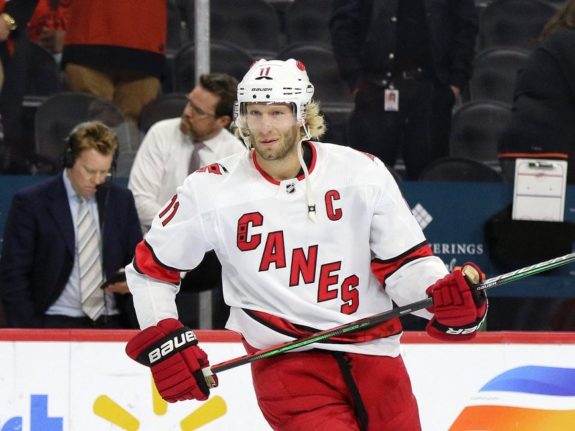
Beyond Staal, the Hurricanes also hit two absolute home runs in the middle rounds of the draft. Jaccob Slavin has developed into one of the best defensive defensemen in the NHL, and selecting him in the 4th round (120th overall) in 2012 has to be one of the bigger “oopsies” from teams around the league in retrospect. Oh, just a little nugget to throw in here, defensemen selected in the top-10 of that draft included Griffin Reinhart, Ryan Murray, Hampus Lindholm, Derrick Pouliot (to Pittsburgh, with the pick received in the Staal deal), and Slater Koekkoek. Yikes.
Last, but not least, another pillar of the Hurricanes blue line came off the board the very next year, once again in mega-steal fashion; Brett Pesce, and elite defender in his own right, was nabbed in the third round, 66th overall, in 2013.
The Hurricanes struggled mightily in the draft for over a decade, but, right at the end of the Rutherford era, a couple pretty nice welcome gifts were left on the doorstep.
The Francis Years (2014-2018): The Slow Play
The inability to find a [starting] goalie and his consistent “we like our group” slogan (when the group clearly wasn’t good enough) doomed him. Aho was a great find and the Teravainen trade was a steal. But a lot of his trades that seemed good at the time, and his assembly of promising prospects, turned out mediocre in hindsight. We saw the vision, but never really saw the results.
Alex Ohari, The Hockey Writers, Tracking the Storm Podcast
These years were stressful for Hurricanes fans anxious for a return to relevancy. They suffered through coaches like Kirk Muller and Bill Peters; the latter hire is one of the bigger stains on Francis’ tenure. The Hurricanes also watched promising young players like Elias Lindholm, Noah Hanifin, and Jeff Skinner get rushed to the NHL too early (or just fizzle out after a great, Calder-winning start in the latter’s case) and fail to live up to expectations.
Francis’ mantra was patience and development, rarely making big trades or free agent signings and instead trying to home-grow a contender. It never truly culminated in success in the standings, but his footprint remains all over the current Hurricanes roster.
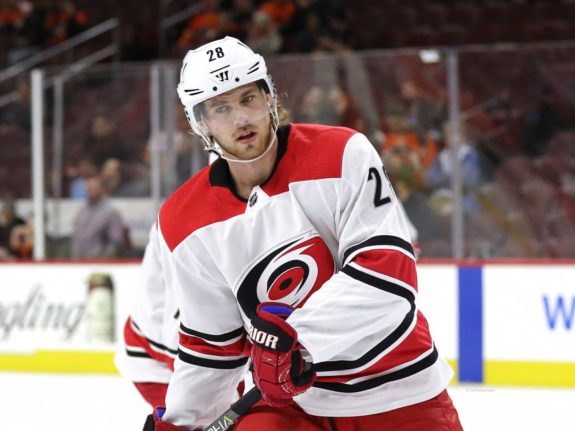
One trade that truly sticks out as a resounding success and possibly the most shrewd move of Francis’ tenure was the Teuvo Teravainen deal.
After a run as one of the most dominant teams in the league, culminating in three Stanley Cups in a six-year span, Chicago General Manager Stan Bowman had to add a sweetener to get his team a little cap relief in order to keep their core intact. Francis swooped in, taking veteran Bryan Bickell’s contract off Chicago’s books, and adding a promising young forward in Teravainen to the mix in the process.
Teravainen has since developed into a top line, nearly-point-per-game player who displays fantastic chemistry with fellow Finn Sebastian Aho. In addition to being a stellar playmaker, he is also one of the most underrated defensive wingers in the league.
As for the draft; we’ve talked about steals already, which should be unsurprising because the Hurricanes roster has quite a few players who outperformed their draft slots. Possibly the single-greatest impact the Francis era has on the 2021 Hurricanes is the biggest of these steals – aforementioned top line center, Aho, taken in the second round (somehow) of the 2016 draft. Robert Kron, now with Seattle but formerly the Hurricanes head European scout, did a phenomenal job of identifying talent that maybe wasn’t as highly regarded by the industry, and Aho is the poster boy for this.
Sadly, Francis’ drafts still left a lot to be desired. He selected a lot of European and college players, again showing his inclination to take things slowly and safely. Even Lindholm was kind of seen as a “safe pick” at fifth overall, although in hindsight it was far from a bad selection.
Other Francis draft additions include goaltender Alex Nedeljkovic (2nd round, 2014) and forward Steven Lorentz (7th round, 2015). “Ned” finally broke through into the NHL this season and the Calder Trophy candidate has been spectacular, cementing his place as a likely key piece of the Hurricanes future in net. Lorentz was a second-year draft eligible forward who has surpassed expectations and turned into a solid part of the Hurricanes bottom six this season, and looks like a legitimate NHL player. Not bad for a guy who was passed over nearly 400 times in the draft.
Francis’ first-round picks left a lot to be desired, though. He did well in adding Martin Necas, who is developing into a star this season. Otherwise, names include Julien Gauthier and Noah Hanifin failed to live up to their immeasurable raw tools in Carolina, Jake Bean, who is still an unknown and has had a roller coaster of a first year in the NHL (largely down of late, and most recently getting scratched for journeyman Joakim Ryan), and Haydn Fleury, who was never able to carve out a role on the deep Canes blue line, though he has looked good early on for his new team in Anaheim.
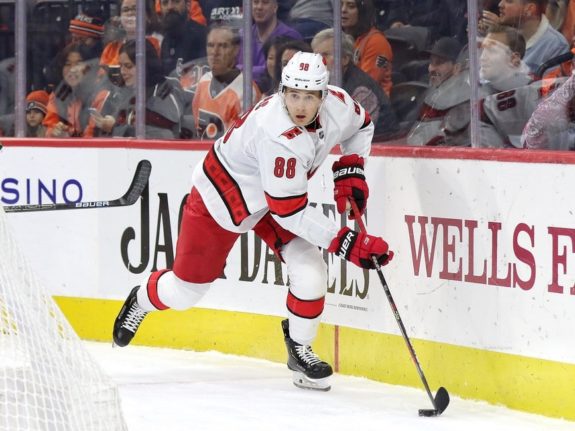
Francis was notorious for standing pat, and the only needle-moving free agent signing he made was adding Justin Williams. But, he did a good job of keeping talent in-house, locking Pesce and Slavin up long-term, and on team-friendly deals to boot. The Hurricanes have been known for having one of the deepest blue lines in the league for a years now, and these two have been at the forefront, so keeping them in tow was a must. On the other end of the spectrum, he also gave Victor Rask a six-year, $24M extension, which predictably went sour quickly.
The Scott Darling trade also sticks out like a sore thumb. Cam Ward was far from an elite goaltender, and for years the Hurricanes looked for an upgrade. They bet on a small sample size from a backup goalie playing behind a championship Chicago team, going back to the Stan Bowman well to add Darling. They then signed him to a four-year deal, but Darling struggled mightily as a Hurricane and the search for a capable starting goaltender continued.
So, in summation, a lot of misses, but a few hits. The patience and passiveness didn’t really pan out like Francis had envisioned, but had he not provided a solid foundation, the Hurricanes wouldn’t look as they do today.
The Dundon/Waddell Era (2018-Present): Pushing in Some Chips, and a Few Strokes of Luck
Waddell and his staff were able to create a Stanley Cup contender by building on Ron Francis’ successes and cutting ties with his failures. Francis helped build the team and acquired or drafted key players, but it’s Waddell that has turned a former laughingstock of the NHL into one of the league’s best teams. His ability to cut ties with “dead weight” and use them as assets to acquire players such as Vincent Trocheck has cemented him as one of the league’s best GMs.
Matthew Somma, Calm Before the Storm/Tracking the Storm Podcast
The summer of 2018 has the potential to be looked back on as the turning point in franchise history, especially if the current trajectory continues and the Hurricanes remain contenders (and, hopefully, win a few Cups in the process) the next half-decade or so. It started with two things; a billionaire from Texas deciding to buy a struggling NHL team and a nice bounce of a ping-pong ball.
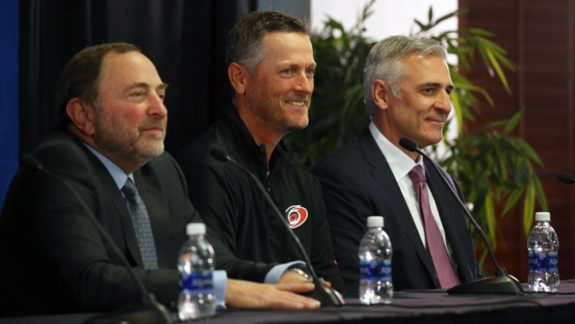
Tom Dundon purchased a majority share of the franchise from longtime owner Peter Karmanos Jr., a move that opened the purse strings for new General Manager Don Waddell – Francis was demoted, then fired almost immediately (from “Hurricanes terminate Ron Francis’ contract”, The News and Observer”, April 30, 2018) – and allowed the Hurricanes finally get a bit over the salary cap.
We can’t have this conversation and not mention the Waddell/Dundon regime’s first move, which was hiring a new head coach. They landed on franchise legend Rod Brind’Amour. His subsequent 84-54-12 record in the two following years, two consecutive playoff appearances (and headed for a third), and Eastern Conference Finals appearance tells you all you need to know about how well that move paid off.
The new regime displayed a much more wheel-and-deal style than Francis. They came in and immediately starting working to improve the roster, signing goalie Petr Mrazek, trading for glue/culture guys Jordan Martinook and Calvin de Haan, and cutting ties with longtime, underperfoming players like Cam Ward, Joakim Nordstrom, and Derek Ryan.
Like Francis with the two young defensemen, Dundon, Waddell, and Brind’Amour were given a hell of a welcome gift – the Hurricanes were the biggest winners in the 2018 NHL Draft lottery, moving up from #11 all the way to second overall. In a draft with a clear-cut top two, and their biggest need at forward, the new front office couldn’t have asked for a better fit. Thus, Andrei Svechnikov became a Carolina Hurricane.
They were far from done at the 2018 draft, though, making one of the biggest splashes that had the draft floor buzzing in Dallas. Elias Lindholm and Noah Hanifin, previous regime staples that the new front office didn’t see as fits, were shipped to Calgary to bring in star defenseman Dougie Hamilton and rugged winger Micheal Ferland.
Still wheeling and dealing to build the team in their image, the Hurricanes then swapped Victor Rask for Nino Niederreiter in a heck of a one-for-one trade. Rask, as previously mentioned, failed to live up to expectations of his hefty contract, and Waddell was able to move a piece that wasn’t working for a forward who has become a valuable piece of their top-six since.That’s phenomenal business, to say the least (also, bless your heart, Paul Fenton).
Immediately ending their decade-long absence from ther postseason, the Hurricanes came just a few games away from a Stanley Cup Final in Dundon, Brind’Amour, and Waddell’s first year at the helm. Waddell was a finalist for Executive of the Year.
Unsatisfied with their taste of success, the team added to their deep blue line once again with veteran free agent signing Jake Gardiner in the summer of 2019, and made another massive splash at the 2020 trade deadline. The Hurricanes, struggling with injuries on their blue line at the time, went out and got Brady Skjei and Sami Vatanen for a first-round pick and Janne Kuokkanen, respectively. Skjei had been fantastic until his recent concussion, eating tough minutes and killing penalties at a high level, while the Vatanen deal was a bit of a miss as he never really got healthy and contributed. Meanwhile, Kuokkanen has turned into a nice young player for New Jersey.
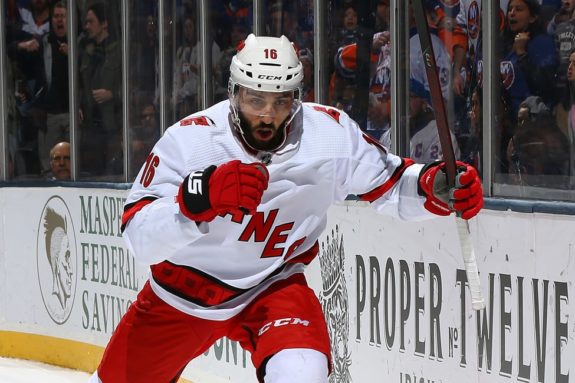
Waddell wasn’t done yet, though. As things began to look like they were quieting down on trade deadline day for the Hurricanes, seemingly out of nowhere Waddell struck with arguably his biggest move yet – adding star forward Vincent Trocheck from the Florida Panthers. Trocheck had fallen out of favor in the sunshine state, with this deal representing a fantastic identification of a buy-low target that has turned into one of the best players on the team. He is scoring at over a point-per-game pace in 2021, and has fit the system with his forechecking, two-way play, and elite hockey sense.
They got a player of this caliber for Erik Haula, who didn’t fit well, Eetu Luostarinen, a nice, young, bottom-six player, and two players that will likely never be NHL regulars in Chase Priskie and Lucas Wallmark. They did not part with one top prospect or draft pick; that’s absolute sorcery to bring in that level of player. And now, with Aho, Trocheck, and Staal down the middle, the Hurricanes have an enviable collection of center depth – one of the biggest strengths on the team.
The hits under Waddell far out-weigh the misses. They have also been phenomenal at the draft, routinely swinging on high-ceiling players that, theoretically, the industry may see as “lower floor”, riskier options than the college-bound and European players Francis seemed to favor. Players like Noel Gunler, Tuukka Tieksola, Alexander Pashin, and Zion Nybeck are not the types Francis likely would have targeted, as super-talented players that fell in the draft over concerns like size, motor, or defensive inefficiencies. These are players that if they hit, though, are probably top-half of the roster players. With the draft being such a crapshoot anyway, this seems like the ideal way NHL scouting departments should be drafting to begin with, but it’s hard to say that definitively before we see how these classes shake out over the next few years. The Hurricanes have the potential to hit quite a few home runs with these selections, though.
So now, you have one of the best teams in the NHL, brought together over a couple short years (this time, Canes fans will likely agree with this moniker – time flies when your team is good, or whatever the saying is), looking like they’ll be going nowhere soon. They’re on the short list of Stanley Cup contenders, and in the mix for the President’s Trophy. They recently showed they can not only battle with, but take the fight to the defending champs.
Waddell has proven to be one of the best managers in the sport, which is just another reason not to count out this franchise staying relevant long-term.
So, Combined, you get…
In summary, the Hurricanes essentially used two different strategies to build one fantastic group.
Francis valued draft picks, was patient, and helped build depth in the prospect pool to keep a steady flow of talent coming. This is easier said than done – projecting and drafting 17 and 18-year-olds is difficult, and frequently teams with lots of early draft picks fail build a contender. Hell, look at the Edmonton Oilers. They would be a dynasty by now if it was as simple as selecting a bunch of talent early and letting the group grow together. Francis’ strategy of patience and building through the draft was the right choice at the time, though, and in the end it did work out for the franchise, thanks to Waddell’s brilliance in turning the foundation into a heck of a complete structure. Both general managers deserve their credit.
Rebuilding is especially tough when you’re a cap-strapped team like the Hurricanes were for so many years. At the end of the day, we don’t know that Francis wouldn’t have preferred being more aggressive and built a more competitive team, because he was hamstrung by a budget that rarely rose above the cap floor under Peter Karmanos Jr.
So in many ways, Dundon can almost be seen as the savior of this franchise. The owner displayed a master class in what a new ownership group should do; coming in very hands-on, opening up new possibilities, putting the right people in place to build the team in his vision, then getting out of the way. I mean really, remember when he took over and so many old-guard, hockey men were all up in arms about his style? Well, when’s the last we heard of them (or Dundon, for that matter)? He said he would fix things, then back off; he’s done just that. He deserves a lot of credit too.
It was a slow, steady process, and the results weren’t always tangible. But, the business and roster management side of this organization has been fantastic the last few years, and the reward is starting to sprout in the form of an extremely good, young, fun team.
The Carolina Hurricanes: former laughingstock of the NHL.
Nobody’s laughing anymore.